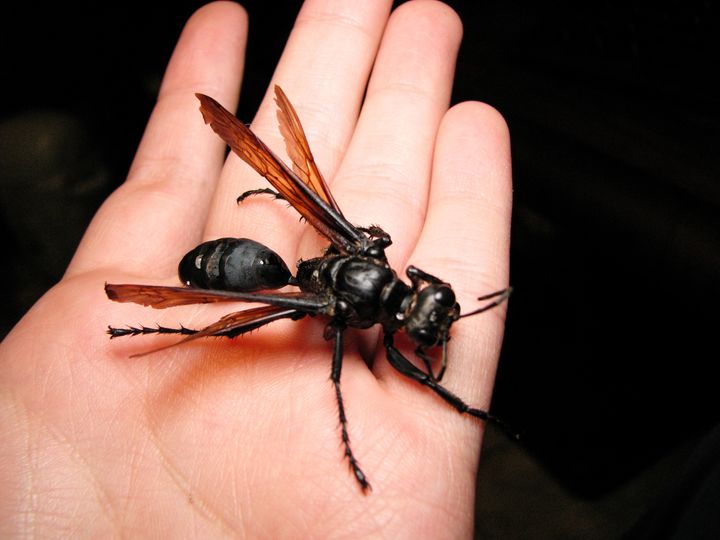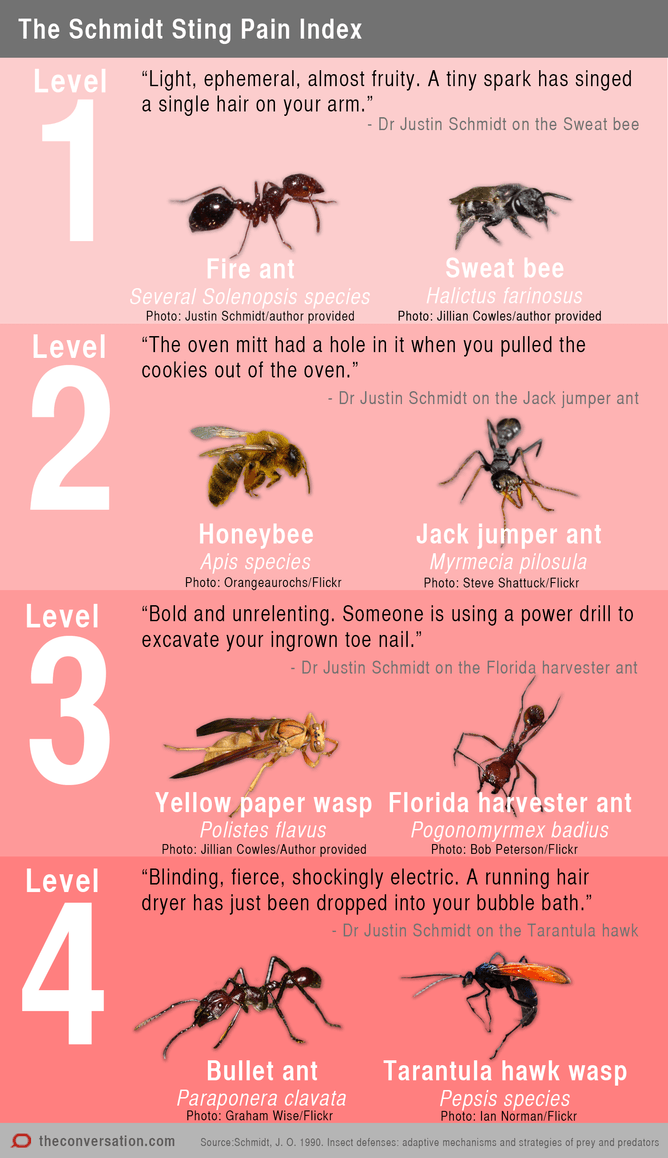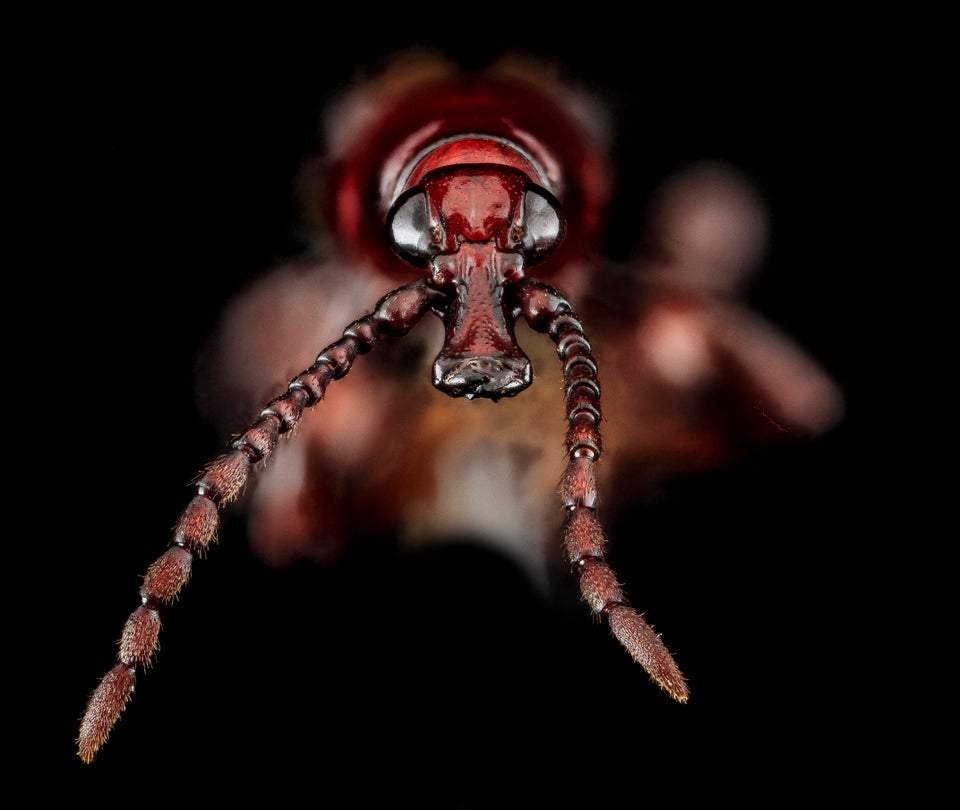
Over the past 40 years (but in reality since I was five years old), I’ve been fascinated with insects and their ability to sting and cause pain. In graduate school, I became interested in why they sting and why stings from such tiny animals hurt so much.
To answer these questions, we first needed a way to measure pain – so, I invented the insect pain scale. The scale is based on a thousand or so personal stings from over 80 insect groups, plus ratings by various colleagues.
Insects sting to improve their lives and increase their opportunities. The stings provide protection, thereby opening doors to more food resources, expanded territories, and social life within colonies. By studying stinging insects, we gain insight into our own lives and the societies we live in.
Why sting?
To say that insects sting “because they can” isn’t all that helpful. The real question is why insects evolved a stinger in the first place. Obviously, it had some value, otherwise it would have never evolved – or, if initially present, it would have been lost through natural selection.
Stingers have two major uses: to get food and to avoid becoming food for some other animal. Examples of the stinger used for sustenance include parasitic wasps that sting and paralyse caterpillars that become food for the wasp young, and bulldog ants that sting difficult prey insects to subdue them.
More importantly, the stinger is a major breakthrough in defence against large predators. Imagine, for a moment, that you’re an average-sized insect being attacked by a predator a million times larger than you. What chance would you have?
Honeybees face this problem with honey-loving bears. Biting, scratching or kicking won’t work. But a stinger with painful venom often does.
In this sense, the stinging insect has found a way to overcome its small size. The stinger is an “insect gun” of sorts – it neutralises the size difference between assailant and victim.
The insect sting pain index
This is where the insect sting pain index comes in. Unless we have numbers to compare and analyse, sting observations are just anecdotes and stories. With numbers, we can compare the effectiveness of one stinging insect’s painful defense against others and test hypotheses.

One hypothesis is that painful stings provide a way for small insects to defend themselves and their young against large mammalian, bird, reptile or amphibian predators. The greater the pain, the better the defense.
Greater defense allows insects to form groups and become complex societies as we see in ants and social wasps and bees. The greater the pain, the larger the society can become. And larger societies have advantages not enjoyed by solitary individuals or smaller societies.
Human and insect societies
Human sociality allows individuals to specialize and do a particular task better than most others. Examples of human specialists include plumbers, chefs, doctors, farmers, teachers, lawyers, soldiers, rugby players and even politicians (a profession sometimes viewed dubiously, but required for society to function).
Social insect societies also have specialists. They forage for food, tend to young, defend the colony, reproduce and even serve as undertakers removing the dead. Another advantage of societies is the ability to recruit others to exploit a large food source, or for the common defense, or to have additional helpers for difficult tasks.
Sociality also has a more subtle advantage: it reduces conflict between individuals within a species. Individuals not living in social groups tend to fight when they come in contact. But to live in a group, conflict must be reduced.
In many social animals, conflict is reduced by establishing a pecking order. Often, if the dominant individual in the pecking order is removed, violent battles erupt.
In human societies, conflict is also reduced via pecking order, but more importantly through laws, police to enforce laws, and gossip and societal teachings to instil co-operative behaviour. In insect societies, conflict is reduced by establishing pecking orders and pheromones, chemical odours that identify individuals and their place in society.
Why do we love pain?
The insect sting pain index also provides a window into human psychology and emotion. Put simply: humans are fascinated by stinging insects. We delight in telling stories of being stung, harrowing near-misses, or even our fear of stinging insects.
Why? Because we have a genetically innate fear of animals that attack us, be they leopards, bears, snakes, spiders or stinging insects.
People lacking such fear stand a greater chance of being eaten or dying of envenomation and not passing on their genetic lineage than those who are more fearful.
Stinging insects cause us fear because they produce pain. And pain is our body’s way of telling us that bodily damage is occurring, has occurred, or is about to occur. Damage is bad and harms our lives and ability to reproduce.
In other words, our emotional fear and infatuation with painful stinging insects enhances our long-term survival. Yet, we have little emotional fear of cigarettes or sugary, fatty foods, both of which kill many more people than painfully stinging insects. Fear of those killers is not in our genes.
The insect sting pain index is more than just fun (which it is too). It provides a window into understanding ourselves, how we evolved to where we are, and what we might expect in the future.
This story was originally published by The Conversation.
Also on HuffPost:
